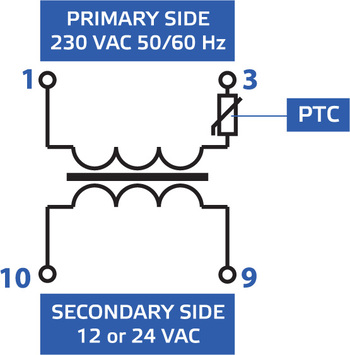Safety transformers - 12 VAC or 24 VAC
Linear power supplies
A linear power supply can only produce a voltage lower than the supply (input) voltage. Sentera’s linear power supply modules utilize transformer technology, thanks to which they operate noiselessly, and their enclosures are designed for DIN rail mounting.
This product group is comprised of compact single-phase safety isolating transformers encapsulated in a plastic modular enclosure.
Safety transformers are used for electrical isolation of the input (main supply) and output (12 or 24 VAC) in power ranges of 25, 40 or 63 VA. They are suitable for creating SELV (safety extra-low voltage) and PELV (protective extra-low voltage) circuits by limiting the output voltage. The units are short circuit and overload protected with a built-in PTC in the primary winding which automatically restores power when the transformer is cooled down or the load is removed.
Transformer technology
A safety transformer, also known as an isolating transformer, is a device designed to provide electrical isolation between the input (main supply) and output circuits. The primary purpose of a safety transformer is to enhance safety by preventing direct electrical contact between the input and output sides. While the primary function is isolation, safety transformers can also be designed to step up or step down voltage levels.
Transformer-based power supplies operate extremely quietly. This is particularly advantageous in applications where minimizing electromagnetic interference (EMI) and maintaining a quiet working environment are essential. Transformers are generally robust and have a long operational life when properly designed and maintained. Their passive nature, without the need for active electronic components, contributes to their reliability.


Built-in PTC thermistor
A PTC thermistor (Positive Temperature Coefficient) is a type of thermistor with a resistance that increases with temperature. In electronic circuits PTCs are employed as overcurrent protectors. As part of a power supply module, they typically serve as a protective component. When there is an excessive current in the circuit, the PTC thermistor heats up, causing its resistance to increase sharply. This rise in resistance limits the current flowing through the circuit, acting as a self-resetting fuse. Also, they limit the inrush current when a device is powered on. The initial surge of current when turning on electronic equipment can be substantial. PTC thermistors help mitigate this by temporarily presenting a higher resistance during power-up, reducing the inrush current and preventing damage to components.
The PTC thermistor within Sentera’s safety transformer series serves as a protective element by responding to overcurrent events. Its positive temperature coefficient ensures that, as it heats up during such events, its resistance increases, limiting the current and protecting the circuit. The self-resetting nature of PTC thermistors allows them to return to normal operation once the overcurrent condition is resolved and the component has cooled down.
